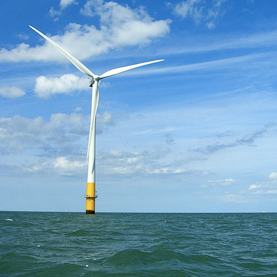 Offshore Wind Turbines Keep Growing in SizeSept. 19, 2011 - ClimateWire - scientificamerican.com
The top offshore turbine makers, Vestas and Siemens, are preparing for rapid market growth and are developing 7-megawatt and 6 MW turbines, respectively. And General Electric Co. is working on a turbine that could be as big as 15 MW -- five times larger than existing offshore machines. There's big money to be made in the North Sea, where the U.K. government aims to install 32 gigawatts in offshore wind capacity in its third licensing round between 2015 and 2025. That's more than 10 times the offshore capacity currently installed in the entire world. The U.K. Carbon Trust estimates the offshore wind market will be worth $52 billion by 2020. "The opportunities in the wind industry are enormous," said Finn Strøm Madsen, president of Vestas Technology R&D. "It's a technology-driven business. From a research and development perspective, it is a very interesting area. Vestas is spending 5.5 percent of its revenue on research and development, which is comparable with Airbus or Boeing." The 7 MW Vestas V164 turbine has more than double the capacity of the biggest offshore machines today, which are 3 MW. It weighs 800 tons without taking into account the underwater foundation, and its 164-meter (538-foot) rotor sweeps an area three times the size of a football field. "This is a dramatic technology development because the rotor is so much bigger than anything on the market today," Madsen said. "The control systems and the software are totally new, and the control mechanisms are very sophisticated and advanced compared with existing wind turbines. The blade shape is different and much more efficient. Overall, it drives down the cost of energy by about 40 percent, which is a very important parameter for our customers." The technical challenge, though, remains daunting. "These products are standing outside for 25 years, and the speed of the tip of the blade on the V164 is 320 kph [199 mph]" Madsen said. "Nothing else on this planet is experiencing the same enormous stress as this turbine. It's very different from an airplane, which flies 15 hours and then lands again to be serviced. You don't take a turbine down for months." Bigger is cheaper, but more complex "Producing electricity with wind offshore is more expensive than onshore, just due to the complexity of it," Madsen explained. "This new turbine is dramatically more efficient, so it's narrowing the gap but still not closing it. The cost of energy is still cheaper onshore." On the other hand, offshore parks generate more power than those on land because winds blow 40 percent more often at sea, according to the European Wind Energy Association. While Vestas won't have a prototype ready for the V164 until next year, Siemens is already testing its first 6 MW turbine offshore from Denmark, and serial production is expected to begin in 2014. Aside from the different capacities, the two rival manufacturers are also betting on different technologies. The Vestas machine will be a conventional geared turbine, while the Siemens one operates with direct drive. In a conventional geared turbine, the rotor turns a large gear, which turns a smaller one, which turns the generator. With direct drive, the turbine directly turns the generator at the same speed as the blades. The generator converts the mechanical energy generated by the blades into usable electrical power. How effective the generator is directly affects how much wind can be converted into electric power. Today, most wind turbines have generators connected to a gearbox. Several turbine makers sell direct drive machines onshore. Siemens itself has two models. Germany's Enercon is the only company to succeed with a direct-drive turbine so far, but its models are only built for onshore installation. Vestas looked into using direct drive on the V164 but decided against it. The company says a geared solution is more efficient, uses a lot less rare earth materials and will need to be serviced less often compared with a direct drive turbine. On the other hand, direct drive weighs less. While in the past the gearbox was the main cause of turbine failures in the industry, now it is electrical systems. And a direct drive turbine has to have four times more electrical components than a geared turbine, which would increase the chance of a malfunction. It's not only expensive to send technicians to repair turbines at sea, but also physically impossible during bad weather. And a turbine that is not running is costing its operator a lot of cash in energy that it is unable to produce. Siemens says its direct drive machine will require less maintenance than existing models. Offshore wind turbines cost much more to install and maintain than onshore ones, so reliability is paramount. The machines require special ships to anchor the turbine foundations and build the towers. The Siemens 6 MW prototype even has a helicopter-hoisting platform integrated in the back of the nacelle to allow easy access for service technicians. |
